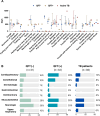This is a preprint.
Prevalence of Long COVID in Mycobacterium tuberculosis- exposed Groups in Peru and Kenya
- PMID: 40343014
- PMCID: PMC12060951
- DOI: 10.1101/2025.04.28.25326537
Prevalence of Long COVID in Mycobacterium tuberculosis- exposed Groups in Peru and Kenya
Abstract
Background: Long COVID (LC), also referred to as post-COVID condition, refers to new or worsening symptoms lasting more than three months after SARS-CoV-2 infection. The prevalence of LC, and the impact of co-infection with prevalent pathogens such as Mycobacterium tuberculosis (Mtb), in low- and middle-income countries remain unclear. We aimed to address these gaps in two Mtb-exposed populations.
Methods: We recruited HIV-uninfected pulmonary tuberculosis (TB) patients (n=36) and their household contacts (n=63) in Peru, and healthcare workers (n=202) in Kenya. We collected clinical data using study instruments adapted from a United States based study of LC. Participants were sampled within 2 years of SARS-CoV-2 diagnosis.
Results: In Peru, 41.4% participants reported LC symptoms, with no TB-associated significant differences in the prevalence or clinical phenotypes of LC. The most common LC symptoms were neurological (e.g., headache and trouble sleeping) and musculoskeletal (e.g., back pain). Kenyan participants reported acute, but no LC symptoms, and reported a decline in the quality of life during acute infection. In Peru, the post-COVID-19 period was associated with a significant decline in all quality-of-life dimensions (p<0.01), except depression and anxiety (p=0.289).
Conclusion: This study shows that LC prevalence was high in Peru, where TB status was not linked to LC symptoms. Those with LC reported high levels of musculoskeletal and neurological symptoms. Unexpectedly, healthcare workers in Kenya denied the presence of LC symptoms. These findings highlight the need for long-term follow-up and larger studies in different geographic settings to dissect the impact of TB comorbidity on LC.
Keywords: COVID-19; Long COVID; post-COVID condition; post-acute sequelae of SARS-CoV-2 infection; tuberculosis.
Conflict of interest statement
Potential conflicts of interest. The authors do not report conflicts of interest.
Figures




Similar articles
-
Mutations in ace2 gene modulate cytokine levels and alter immune responses in Mycobacterium tuberculosis and SARS-CoV-2 co-infection: a Cameroonian cohort.Front Immunol. 2025 Mar 24;16:1533213. doi: 10.3389/fimmu.2025.1533213. eCollection 2025. Front Immunol. 2025. PMID: 40196114 Free PMC article.
-
A review of Patient Reported Outcome Measures (PROMs) for characterizing Long COVID (LC)-merits, gaps, and recommendations.J Patient Rep Outcomes. 2024 Aug 26;8(1):101. doi: 10.1186/s41687-024-00773-1. J Patient Rep Outcomes. 2024. PMID: 39186150 Free PMC article. Review.
-
Cascade Immune Mechanisms of Protection against Mycobacterium tuberculosis (IMPAc-TB): study protocol for the Household Contact Study in the Western Cape, South Africa.BMC Infect Dis. 2022 Apr 15;22(1):381. doi: 10.1186/s12879-022-07349-8. BMC Infect Dis. 2022. PMID: 35428268 Free PMC article.
-
Clinical characteristics, anti-SARS-CoV-2 IgG titers, and inflammatory markers in individuals with post-COVID-19 condition in Kenya: a cross-sectional study.PeerJ. 2024 Jul 22;12:e17723. doi: 10.7717/peerj.17723. eCollection 2024. PeerJ. 2024. PMID: 39056056 Free PMC article.
-
Screening tests for active pulmonary tuberculosis in children.Cochrane Database Syst Rev. 2021 Jun 28;6(6):CD013693. doi: 10.1002/14651858.CD013693.pub2. Cochrane Database Syst Rev. 2021. PMID: 34180536 Free PMC article.
References
-
- World Health Organization (WHO). A clinical case definition of post COVID-19 condition by a Delphi consensus. 2021.
-
- Proal AD, VanElzakker MB, Aleman S, Bach K, Boribong BP, Buggert M, et al. SARS-CoV-2 reservoir in post-acute sequelae of COVID-19 (PASC). Nat Immunol. 2023. Oct 4;24(10):1616–27. - PubMed
-
- Proal AD, Aleman S, Bomsel M, Brodin P, Buggert M, Cherry S, et al. Targeting the SARS-CoV-2 reservoir in long COVID. Lancet Infect Dis. 2025. Feb 10. - PubMed
Publication types
Grants and funding
LinkOut - more resources
Full Text Sources
Miscellaneous
